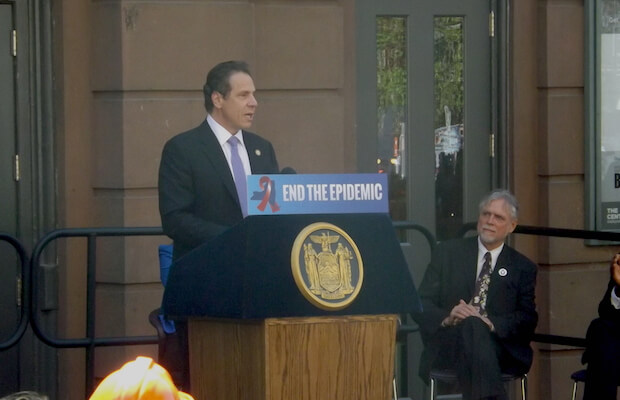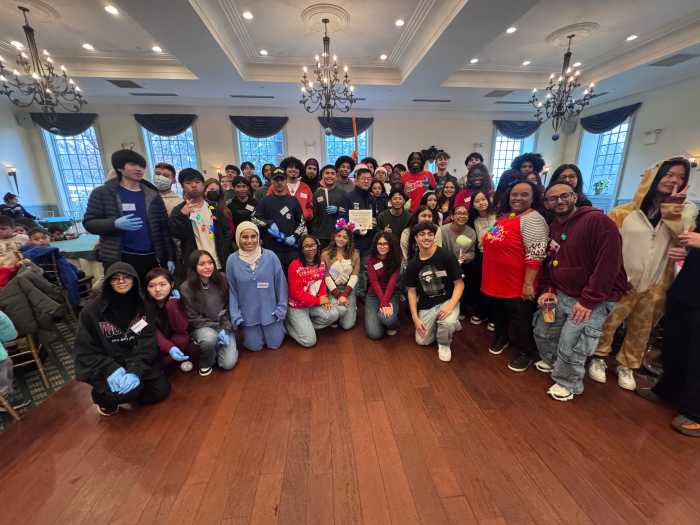Nahuel Pérez Biscayart in Robin Campillo’s “BPM (Beats Per Minute),” about ACT UP in 1989 Paris. | CEÌLINE NIESZAWER/ THE ORCHARD
“BPM (Beats Per Minute)” is co-writer and director Robin Campillo’s urgent, cogent film about ACT UP in 1989 France. This absorbing and moving drama opens with an action by the group at a medical convention that is recounted in one of its talky weekly meetings. It is an effective approach to immersing viewers in ACT UP’s approach to its work.
The film introduces Nathan (Arnaud Valois), who is HIV-negative and has started attending the meetings. He gets swept up — and viewers will, too — in the talking, the in-fighting, and the actions, such as disrupting a pharmaceutical company and demanding test results for AIDS drugs. Nathan soon finds himself attracted to Sean (Nahuel Pérez Biscayart), who is positive, and they begin a passionate relationship.
Robin Campillo’s “BPM (Beats Per Minute)” captures ACT UP’s transformative energy
On the phone from France, Campillo spoke with Gay City News about making “BPM (Beats Per Minute).”
GARY M. KRAMER: You were part of ACT UP Paris. How did you incorporate your experiences for “BPM?”
ROBIN CAMPILLO: It was 1982 when AIDS hit France, and I was 20 years old. I was really afraid of what was going on with AIDS. I heard about ACT UP from a friend of mine who was touched by the disease. I went through the 1980s really frightened. I went to ACT UP in 1992. For me, it was quite a relief to be in this group. There was so much energy and electricity. The worst moments of AIDS in France were the early 1990s. I wanted to talk about the jubilation. The first meeting I attended, I thought that it was weird because it was so much fun. People were laughing. “Where was the disease?,” I thought. People were so full of energy, but the fear came back quickly, so I wanted to show these moments.
GMK: Why tell this story now? How is it timely?
RC: I made the film when I could do it. I wanted people, especially young gay men, to have a genealogy. I wanted to connect people to the emotions, sensations, and sexuality of the early 1990s. I’m not trying to lecture the audience. It’s more important to make people feel what people were feeling at the moment. Of course, today, it’s another moment in the epidemic — I am grateful that PrEP is working — but I wanted to show there was no choice and the condom was an obligation for us. I was shocked that some of the actors, most of whom are gay, didn’t know what ACT UP was. I had to explain it to them.
GMK: Like your previous film, “Eastern Boys,” “BPM” depicts characters getting a kind of renewed shot at life. What observations do you have about that theme in you work?
RC: I think — as it is with the character in “Eastern Boys” —that moments of metamorphosis are rare in life. You don’t get many chances to mutate your life or reinvent yourself. For me, my position of being a director is the same as the character of “Eastern Boys”: I want to be invaded by others to change myself and my point of view.
In my films, I try to show these moments of mutation — the characters change their behavior in front of you because they are confronted with something. For Nathan in “BPM,” he’s getting a second chance. He missed this first part of his life, and his involvement in ACT UP provides a way for him to be different than he was.
I try even in editing the work to create a kind of metamorphosis. I changed the climate of the scenes, like the dancing scenes in the club — you can see this particle in the air and then you see it’s plasma. I love this idea that the cinema is mutating. I tried in my cinema to reinvent myself.
GMK: What went into recreating the actions in the film?
RC: All those scenes are based on my memories. I was part of all these actions. I like the scene in the school, where ACT UP interrupts a classroom to talk about HIV transmission. You can see this younger student in the background and he is looking at this action like a spectator. You don’t know if he’s gay, but I love the idea he was waiting for something to happen in his life, and this group appears. He’s just a face. He’s a little sexy, but we don’t know what’s going on in his head.
GMK: There is an erotic scene between Nathan and Sean in a hospital room. Can you talk about this intimate moment?
RC: Obviously, in a film about AIDS, it is important how sex is portrayed. Sean is concerned that he could transmit HIV, so we wanted to show it being very safe.
I know from HIV-positive friends that they were always concerned about sex. My first boyfriend died from AIDS. I show his face when I show photos of people who died. I miss his body. I miss the fact that I can’t touch him. So it was important to put that in.
When you meet someone, you know his body. Sean and Nathan are about sensuality. The hospital scene was important because you understand they stopped having sex, and it’s a sad thing.
It’s a problem when you have a couple with HIV or someone is sick. You don’t know when to stop having sex, and for me that scene was important because they loved each other. You can feel how it’s sensual and sexual and caring. There was nothing dirty about it. I don’t try to shock people. I show how human we were in these situations and how difficult it was to cope.
BPM (BEATS PER MINUTE) | Directed by Robin Campillo | The Orchard | In French with English subtitles | Opens Oct. 20 | Angelika Film Center, 18 W. Houston St. at Mercer St.; angelikafilmcenter.com/nyc | Film Society of Lincoln Center, 144-165 W. 65th St.; filmlinc.com


































